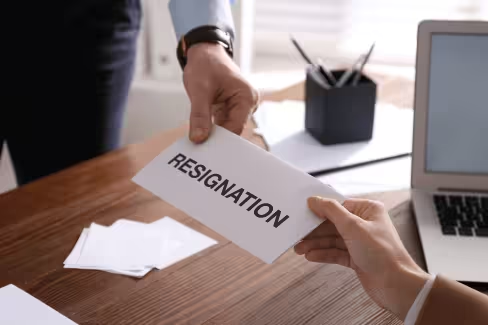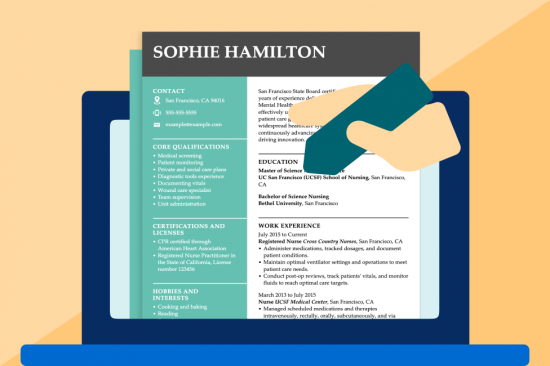How to Write a Resignation Letter [ 75 Examples]
A letter of resignation can help you leave a job while keeping doors open for future recommendations. Here, we’ll explain how to write a resignation letter and provide a template, plus provide 75+ examples.
What is a letter of resignation?
A resignation letter is a document sharing your plans to stop working for your current employer. It’s a formal step that confirms when you will cease being an employee.
Usually, it’s submitted after you’ve talked with your manager about leaving.
Its goals are to share the last day you’ll work, express thanks, and help the employer by creating a paper trail and reminding them to plan. It consists of a greeting, two to three paragraphs and your signature.
Do you need a letter of resignation?
There are no federal or state laws requiring resignation letters. However, some businesses request resignation letters and may outline the resignation letter process in their employee handbook.
A letter of resignation is a polite gesture to show your previous employer that you valued your time with them and care about how your departure may affect the company.
It allows you to leave on good terms if you need a reference or referral in the future.
What to include in a letter of resignation template

A well-written letter of resignation should include:
Here’s a sample resignation letter template you can copy/paste:
[Month] [Day], [Year]
Dear [Your Boss’ Name],
Please accept this formal notice that I am resigning from my role as a [position title] with [Company Name]. My last day will be [last date you can work, usually two weeks minimum from today’s date]. This decision has not been made lightly, and I am sincerely grateful for my time at [Company Name], thank you.
The past [length of time you’ve had this job] have taught me a lot and helped me grow professionally. In particular, I appreciated the chance to [a few of your favorite job achievements or responsibilities]. I’ve learned [mention specific things you learned from this job]. I will carry these lessons and skills into future projects.
I’d like to do everything possible to help the team transition and wrap up my duties in these next two weeks. Please let me know if there’s anything I can do to make this adjustment smooth. I wish the company continued success and hope to keep in touch.
Gratefully,
[Your Name]
Once you’ve copied and pasted this letter or resignation template into an email or document, make sure you personalize it with your information
How to write a resignation letter
Here, we’ll explain how to nail each part of your resignation letter.
1. Date
Include the date at the top of your resignation letter so that it’s clear when you’re giving notice. The professional standard for resignation letters is offering two-weeks notice before your last day.
2. Greeting
Address your resignation letter to your direct supervisor or a human resources manager.
If you are familiar with the person receiving the letter, you can use their first name. Or address them how you usually do. If you haven’t spoken before, use the general salutation for business letters, meaning the person’s first and last name (“Dear Gina Snipes”).
You may also write a letter to your team, department or organization. However, before you announce your departure to a group, ensure you’ve notified your supervisor separately first!
3. Resignation statement
The first paragraph of your letter of resignation should clearly state your intention to resign, your job title and the company by name.
Though not necessary, some people share the reasons for their departure when they’re positive like they want to return to school or have received an exciting offer to further their career.
Resignation statement example:
“It is with a heavy heart that I tender my resignation as a paralegal here at Johnson & Wolfram. After much thought, I have decided that I would like to pursue a career in SEO, which aligns with my passion for technology and information architecture.”
4. Last day of work
Letting an employer know how long they can expect your service greatly helps them plan how the business will operate without you.
Again, two weeks notice is standard. If you give less than two weeks’ notice, put the date in bold so that it jumps out and the employer knows they should get planning.
5. Thanks and gratitude
Show thanks for the opportunity, things you’ve learned or the chance to have worked with your boss and coworkers.
Resignation letter gratitude example:
“I’m thankful for the opportunity I’ve had these past two years working closely with you and our incredible team. It’s taken my customer service skills to the next level and helped me grow professionally.”
6. An offer to help the transition
Here, you can offer your employer any help that could make the transition of your departure run smoothly.
A simple offer of assistance shows that you care about the business, your teammates and your work. And that you hope business will flourish after you’re gone.
It will also imply that you plan on being responsible and working hard until the very last day of your work.
Offer to help example:
“Please let me know how I can be helpful in any training or transitioning my exit requires.”
7. Signature
To end your letter, use a professional salutation like “Kind regards,” “Respectfully,” “Sincerely,” or “Thankfully,” and then include your full name and job title.
Suppose you want to keep in touch with your manager after you leave. In that case, providing your phone number or suggesting connecting on LinkedIn, Instagram or Facebook is also acceptable.
Resignation letter signature example:
Kind regards,
Belinda Markins
Sr. Product Designer
P.S. I hope to stay in touch after working together. Please feel free to add me on LinkedIn or call me at (555) 555-5555.
Resignation letter mistakes to avoid
Leaving a job can be an emotional experience, especially if you’re leaving because of unhappiness with your role, the management or working conditions.
You don’t want to submit a resignation letter that adds insult to injury and burns bridges.
Avoid the following resignation letter mistakes:
- Using the letter to express frustration(s) about your current employer.
- Mentioning your new employer.
- Creating a tone that seems like you’re excited to be done working for your employer.
Your resignation letter isn’t the space for criticism, feedback or negativity.
If you have significant concerns, problems or feedback, it’s better to discuss them in other ways, like during an exit interview with your boss or with HR.
Complaining about things you didn’t like about your job could harm your professional reputation.
It may also be a bad last impression for your employer, which could haunt you if they’re ever contacted as a reference when you apply for future jobs!
Also, never send a resignation letter until you have a plan for what you’ll do after this role, whether it be helping family, school or another job.
It’s best to submit a letter of resignation only after you have a plan in place for what you’ll do after this role, whether it be helping family, school or another job!
So, ensure you have a well-written resume if you need to apply for a new position.
Check out our best tool for that task, our Resume Builder. It automates the resume writing process so you can complete your resume in under 15 minutes!
Resignation letter examples
It may help you to write your resignation letter by looking at a few examples.
Here, we have resignation letter samples for specific quitting situations and examples organized by job type.
We also have some text-based resignation letters that you can copy/paste below!
Letter of resignation examples for specific quitting situations:
- Resignation Letter Due to Family Illness
- Resignation Letter Due to Pregnancy
- Resignation Letter With Regret
- Resignation Letter Due to Family Reasons
- Resignation Letter With Intent to Return
- Resignation Letter Due to Stress
- Resignation Letter with 30-Day Notice
- Resignation Letter from Full Time to Part Time
Letter of resignation examples by job type:
- Accountant Resignation Letter
- Administrative Assistant Resignation Letter
- Automotive Technician Resignation Letter Sample
- Bartender Resignation Letter Sample
- Behavior Specialist Resignation Letter Sample
- Bus Driver Resignation Letter
- Call Center Representative Resignation Letter Sample
- Caregiver Resignation Letter
- Cashier Resignation Letter
- CEO Resignation Letter
- Certified Nursing Assistant Resignation Letter
- Committee Resignation Letter
- Crew Member Resignation Letter
- Data Entry Clerk Recommendation Letter Sample
- Daycare Resignation Letter
- Dental Assistant Resignation Letter
- Director Resignation Letter
- Faculty Resignation Letter
- Fashion Assistant Buyer Cover Letter Examples
- Fast Food Server Resignation Letter
- Front Desk Clerk Resignation Letter
- General Manager Resignation Letter
- Hairstylist Resignation Letter
- Internship Resignation Letter
- Housekeeper Resignation Letter
- Human Resources Manager Resignation Letter
- Lawyer Resignation Letter
- Loan Officer Resignation Letter
- Massage Therapist Resignation Letter Sample
- Medical Assistant Resignation Letter Sample
- Military Resignation Letter
- Nanny Resignation Letter
- Nonprofit Board Resignation Letter
- Occupational Therapist Resignation Letter Example
- Office Assistant Resignation Letter
- Pastor Resignation Letter
- Physical Therapist Resignation Letter Example
- Principal Resignation Letter to Parents
- Professor Resignation Letter
- Quality Assurance Resignation Letter Sample
- Receptionist Resignation Letter
- Sales Associate Resignation Letter
- Security Officer Resignation Letter
- Server Resignation Letter
- Social Worker Resignation Letter
- Store Manager Resignation Letter
- Teacher Resignation Letter to Parents
- Team Lead Resignation Letter
- Technical Support Resignation Letter Sample
- Treasurer Resignation Letter
- Truck Driver Resignation Letter
- Software Testing Resignation Letter
- Supervisor Resignation Letter
- Warehouse Associate Resignation Letter Example
Here are some well-written resignation letter samples that you can copy and paste and customize with your information:
Resignation letter example #1:
Jan. 8, 2024
Dear Amanda,
This letter is to inform you that I am resigning from my position as senior product designer at Lightseeker Technologies, effective January 30th.
The past four years with Lightseekers have been immensely enriching and essential to my life and professional development. I’m grateful for all the guidance and support you’ve given me and the chance to be part of such a dynamic and fantastic team.
Please let me know how I can help during the transition period. I wish you and our whole team all the best.
Sincerely,
Tyrone Biggs
P.S. I hope that we can stay in touch. So, I requested a connection on LinkedIn, and you have my number, so feel free to reach out if you ever want to grab a coffee!
Resignation letter example #2:
Nov. 29, 2023
Dear Tony,
With a heavy heart, I tender my resignation as the account manager for Manley Motors. My last day will be on December 22.
The past eight years have been a wonderful experience. I appreciate the opportunities you’ve given me to learn and grow, and I value all of the professional relationships I’ve been able to cultivate here.
Please let me know if there is any way I can assist with the transition. And I hope we stay in touch!
Kind regards,
Nate LePine
Key takeaways
To recap, here are the main points you need to know for how to write a letter of resignation:
- Address the letter to your immediate supervisor
- Right away mention that the letter’s purpose is to inform them of your exit
- Cite your job title and your company name
- Mention why you’re leaving only if it’s for positive reasons, e.g., education, family or professional growth
- Thank the employer for the opportunity to work for them.
- Mention your favorite things about working for their company or how it helped you grow.
- Offer to help make your transition out of the company seamless and easy.
- Sign off politely
- Encourage the manager to stay in touch if it feels appropriate!
Featured in:*

*The names and logos of the companies referred to in this page are all trademarks of their respective holders. Unless specifically stated otherwise, such references are not intended to imply any affiliation or association with LiveCareer.






